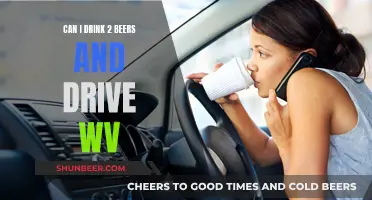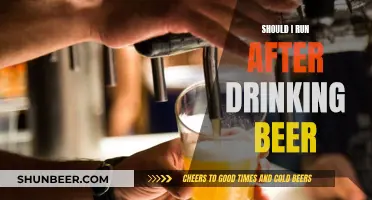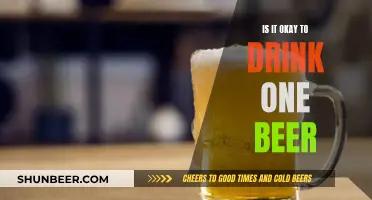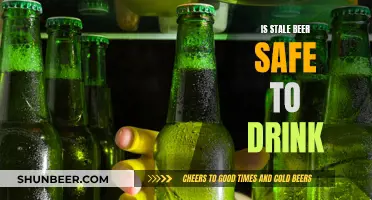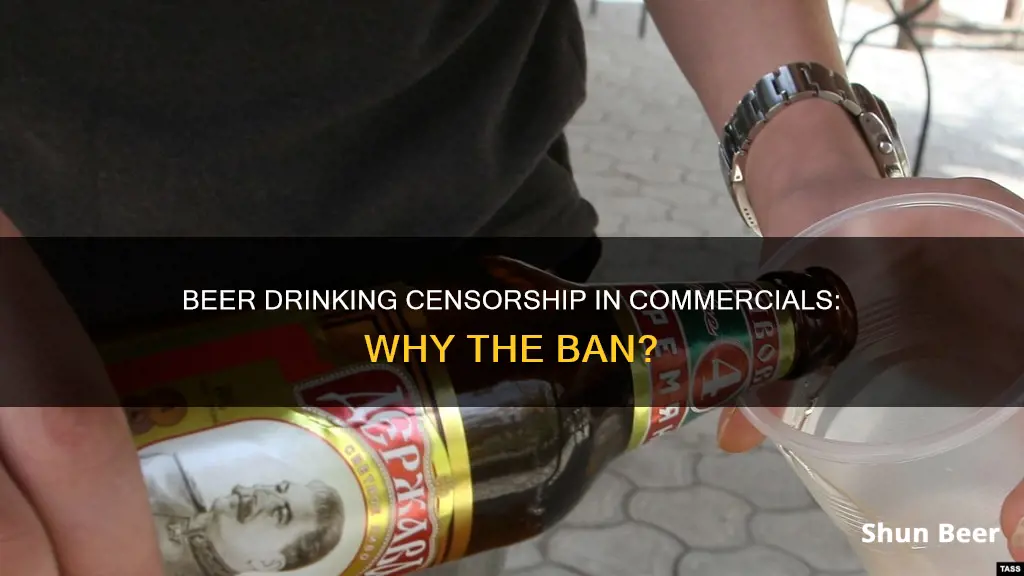
Beer commercials are a common sight on television, but you'll rarely see actors taking a sip of the beverage. This has created the misconception that drinking in commercials is banned or illegal. While there are no government regulations preventing advertisers from showing people drinking beer, most producers avoid it due to industry guidelines that date back to the end of prohibition. Television agencies advise advertisers against depicting alcohol consumption, but there are no legal restrictions on what can be shown beyond banning outright fraud. Self-regulation by advertising agencies and broadcasters is the primary reason for the absence of drinking in beer commercials, rather than government intervention.
| Characteristics | Values |
|---|---|
| Legality | No government law prohibits showing beer drinking in commercials |
| Industry Regulation | Beer companies self-regulate their advertising |
| Audience | At least 70% of the audience must be over 21 |
| Social Media | Platforms like TikTok ban alcohol advertising |
What You'll Learn
- Beer commercials can show people drinking without legal repercussions in some countries, like the UK and Germany
- In the US, the government does not prohibit beer drinking in commercials, but TV networks do
- Beer companies are cautious about their advertising to avoid stirring a cry for a new law
- The Tobacco Tax and Trade Bureau (TTB) regulates alcohol advertising, but relies on self-regulation by the industry
- Social media platforms have their own regulations for alcohol advertising, with some like TikTok banning it altogether

Beer commercials can show people drinking without legal repercussions in some countries, like the UK and Germany
In Germany, there are three different sets of regulations that refer specifically to alcohol marketing and advertising: the statutory 'Jugendschutzgesetz' and 'Jugendmedienschutz-Staatsvertrag', and the non-statutory 'Code of Conduct on Commercial Communication for Alcoholic Beverages'. The Jugendschutzgesetz' focuses on the broadcast time of commercials, stating that they cannot be shown before 6 pm. The Jugendmedienschutz-Staatsvertrag includes a similar time restriction and also states that advertising for alcoholic beverages must not be directed towards minors or show them drinking. The Code of Conduct, designed by the advertising and alcohol industry, is the main regulation for alcohol marketing and advertising in Germany.
In the UK, there are no known restrictions on depicting alcohol consumption in commercials. This is in contrast to the United States, where the networks' self-imposed regulations have been in place for decades. While some US network executives have indicated a willingness to re-evaluate these rules, any changes are unlikely to be made soon.
The regulations, or lack thereof, regarding the depiction of alcohol consumption in commercials vary across different countries. While the UK and Germany allow it, other countries like the United States have industry-imposed restrictions. These variations in regulations highlight the diverse approaches taken by different countries in navigating the promotion of alcoholic beverages to the public.
DayQuil and Beer: A Safe Mix?
You may want to see also

In the US, the government does not prohibit beer drinking in commercials, but TV networks do
In the US, the government does not prohibit beer drinking in commercials; however, TV networks have their own regulations that ban the act. While the government has not specifically prohibited commercials from showing alcohol consumption, among advertisers and TV stations/channels, there is an official (but not legally binding) agreement not to show people drinking alcohol in a commercial. This is because advertisers are loath to take chances with network policy.
The Federal Communications Commission (FCC), the body in charge of decency and other rules for broadcasters, has stated that "Congress has not enacted any law prohibiting broadcast advertising of any kind of alcoholic beverage, and the FCC does not have a rule or policy regulating such advertisements." This means that, legally, advertisers can show alcohol consumption in their commercials. However, the major networks have their own rules and are free to set their own standards, and as it stands, they frown upon public displays of ingestion when it comes to beer.
The self-regulation of the alcohol industry is unique, and it is based on guidelines from the Distilled Spirits Council of the United States (DISCUS), the Beer Institute (BI), and the Wine Institute (WI). The Beer Institute, the voice of brewers, has stated that their members are cautious about adhering to network policies. They want to avoid the risk of stirring up a cry for a new law, and so they self-regulate. This self-regulation has been the way the industry has operated for decades, and there is little demand to change it.
The restrictions on showing beer drinking in commercials are not due to government regulations but rather the TV networks' policies. These policies are effective in shaping the content of commercials, even though they are not legally binding. As a result, beer advertisers must be conservative in their approach to ensure their commercials air across all networks.
Beer and Omeprazole: Is It Safe to Drink?
You may want to see also

Beer companies are cautious about their advertising to avoid stirring a cry for a new law
The self-regulation of the alcohol industry is based on guidelines from the Distilled Spirits Council of the United States (DISCUS), the Beer Institute (BI), and the Wine Institute (WI). The Beer Institute, the voice of brewers, has stated that its members are reluctant to test the boundaries of network policies. The institute's director of communications, Megan Kirkpatrick, said that brewers have no desire to stir things up and risk a call for new legislation. Kirkpatrick added that self-regulation is a long-standing practice for brewers and that they would not want to jeopardize it.
The television networks, not the government, enforce the restrictions on depicting beer drinking in commercials. While these restrictions lack the force of law, they are effective in shaping beer advertising. The networks are free to set their own standards, and as a result, the public display of beer ingestion is generally frowned upon.
The alcohol advertising restrictions vary across different platforms and countries. For example, social media platforms like TikTok have banned alcohol advertising altogether, while Facebook, Twitter, Snapchat, and YouTube allow it with certain restrictions. Google's alcohol advertising policy aims to prevent alcohol advertising in countries where it is banned and irresponsible alcohol advertising.
The history of alcohol advertising restrictions in the US dates back to 1936, just three years after the end of prohibition. While liquor companies were banned from advertising on radio and TV, beer and wine companies were exempt. It was not until 1996 that liquor companies resumed advertising on these platforms. Despite some backlash, they have continued to advertise, and courts have repeatedly struck down regulations and bans on alcohol advertising.
Beer and Imodium: Safe Mix or Not?
You may want to see also

The Tobacco Tax and Trade Bureau (TTB) regulates alcohol advertising, but relies on self-regulation by the industry
The Tobacco Tax and Trade Bureau (TTB) is a bureau of the United States Department of Treasury that regulates and collects taxes on trade and imports of alcohol, tobacco, and firearms within the United States. The TTB enforces the provisions of the Federal Alcohol Administration Act (FAA Act) to ensure that only qualified persons engage in the alcohol beverage industry. The FAA Act includes provisions to regulate the marketing and promotional practices concerning the sale of alcohol beverages.
While the TTB does regulate alcohol advertising, it does not have a rule or policy regarding the depiction of alcohol consumption in commercials. The restriction on showing alcohol consumption in commercials is a self-imposed regulation by the television networks and advertisers. The networks are free to set their own standards, and as it stands, they frown upon publicly displaying ingestion. This is not a legal restriction, but rather an industry standard that advertisers must adhere to if they want their commercials to air.
The self-regulation by the industry is driven by a desire to avoid stirring up controversy and risking calls for new laws or regulations. The Beer Institute, the voice of brewers, has stated that its members are cautious about taking chances with network policy. They prefer to be conservative in their advertising to ensure their commercials are aired without issue.
While the TTB does not directly regulate the depiction of alcohol consumption in commercials, it plays a crucial role in ensuring that alcohol advertising provides adequate information to consumers and prevents misleading or deceptive practices. The TTB's Advertising, Labeling, and Formulation Division (ALFD) enforces statutory and compliance provisions of the Internal Revenue Code and the FAA Act, ensuring that alcohol labeling and advertising comply with federal laws and regulations.
Drinking Beer on Key West's Sidewalks: What's Allowed?
You may want to see also

Social media platforms have their own regulations for alcohol advertising, with some like TikTok banning it altogether
In the United States, the Federal Alcohol Administration (FAA) Act gives authority to the Alcohol and Tobacco Tax and Trade Bureau (TTB) to regulate the alcohol beverage industry and protect consumers. The TTB has set out general guidelines for alcohol marketers to follow when advertising on social media, including mandatory statements informing consumers that alcohol can be harmful when consumed in excessive amounts and should not be sold to underage consumers.
Additionally, social media platforms have their own guidelines and policies regarding alcohol advertising. For example, Facebook requires alcohol brands to include age affirmation before allowing users to follow or view their content. Twitter also has an age-screening feature to ensure that only users of legal drinking age can follow alcohol brands. Instagram, on the other hand, does not currently provide a way for users to verify their age, which restricts two-way conversations between alcohol brands and their customers.
Despite these regulations, alcohol companies have found ways to target young people on social media. They use sponsored ads, personal data, and influencers to reach a wider audience, including minors. This has led to concerns about the effectiveness of self-regulation in the alcohol industry and the need for better advertising standards to protect young people from exposure to alcohol advertising.
Exploring Beer Drinking Laws in Maine's Great Outdoors
You may want to see also
Frequently asked questions
No, it is not illegal. There is no government rule or law prohibiting the broadcast advertising of alcoholic beverages. However, each television network has its own rules and guidelines that advertisers must follow if they want their commercial to air.
Television networks restrict the depiction of beer drinking in commercials to avoid stirring things up and risking a cry for a new law. They prefer to self-regulate and maintain the status quo rather than risk stricter regulations or a ban on alcohol advertising.
Yes, there are countries with stricter regulations on alcohol advertising. For example, in Germany, it is considered a sign of alcoholism to hold a beer bottle above a specific angle in a commercial. In India, any commercial for alcohol is banned, and alcohol companies advertise drinking water and music CDs instead.



